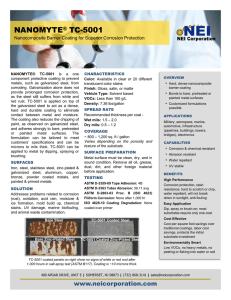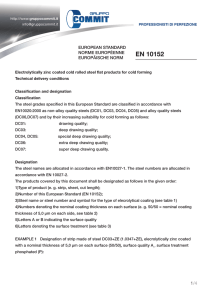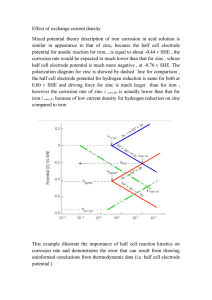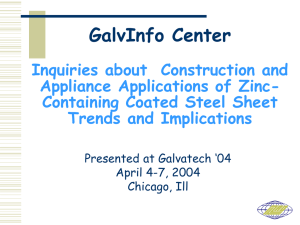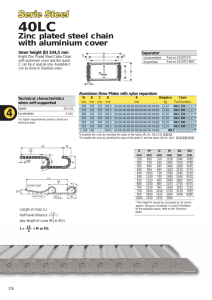Properties of a 55% Aluminium-Zinc Coating on Steel Sheeting
advertisement
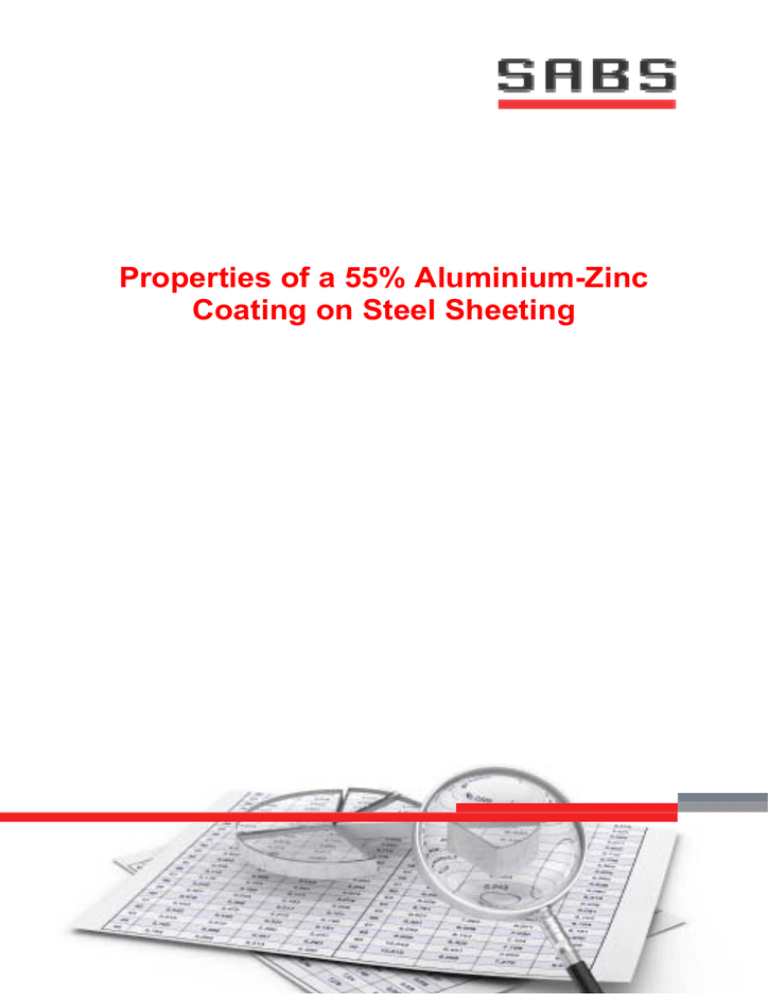
Properties of a 55% Aluminium-Zinc Coating on Steel Sheeting SABS wishes to thank the valuable contributions of the following persons to this publication: Dr. A.J. O’Donnell, Managing Member, Generation Consumable Supplies Prof. G.T. Van Rooyen, Professor Emeritus, Department of Material Science and Metallurgical Engineering, University of Pretoria Dr. G.R. Visser, Research Fellow in the Office of the CEO, South African Bureau of Standards R.T. White, Regional Director International Zinc Association Properties of a 55 % Aluminium‐Zinc Coating on Steel Sheeting 1. Introduction The aluminium‐zinc (AZ) coating on steel sheeting consists of nominally 55 % aluminium, 43,4 % zinc and 1,6 % silicon, and it is applied by hot dipping in a molten bath. This coating was developed by the Bethlehem International Engineering Company (BIEC Inc.) in the USA, now a fully owned subsidiary of BlueScope Steel, Australia. It is produced in accordance with ASTM A 792, and is sold under license by BIEC Inc. in numerous countries worldwide, under a variety of brand names such as Zincal®, Zincalume®, Aluzinc® and Galvalume®. In South Africa, the standard for AZ‐coated steel sheeting is SANS 9364, approved by National Committee TC 107, Metallic and other inorganic coatings, and published by the South African Bureau of Standards. The standards for conventional galvanized steel (GI) sheeting are SANS 3575 and SANS 4998, also approved by National Committee TC 107, Metallic and other inorganic coatings, and published by the South African Bureau of Standards. 2. History In 1962, the Homer Research Laboratory of Bethlehem Steel commenced investigations into a range of AZ coatings applied to steel in the range 0 % to 70 % aluminium. After approximately eight years of continued development, the results clearly indicated that the 55 % AZ coating was the optimum coating composition. The results obtained after 13, 20, 22, 25 and 30 years of atmospheric exposure at rural, industrial, marine and severe marine sites (Townsend & Borzillo 1995; Zoccola, Townsend, Borzillo & Horton 1978; Townsend & Zoccola 1979; Townsend & Borzillo 1987; Townsend, Borzillo & Barker 1989; Townsend 1993) demonstrated that the AZ coating was at least two to four times more corrosion resistant in all atmospheric test sites than conventional galvanized coating (GI) of similar thickness. In the early development work, it was found that it was impossible to coat steel by the continuous hot‐dip process in aluminium‐zinc molten alloy baths approaching the 50 % aluminium composition. This was due to an excessive alloying reaction with the immersed steel, which was so extremely exothermic in nature that it produced intermetallic "rubble" in the process. In 1963, a breakthrough took place when it was established that a small amount of silicon (e.g. the addition of approximately 2 % of the aluminium content of the molten bath) effectively suppressed the unwanted excessive alloying reaction (Townsend 1986). This was the important breakthrough that allowed development of the current AZ coating to proceed. The cumulative worldwide production now exceeds 70 million tonnes with a present annual production of 7 million tonnes (GalvInfoNote 1.4. 2011). 55 % AZ coated sheeting is widely used unpainted and exposed directly to the atmosphere. It can also be used as a base for pre‐painted sheeting. 3. Coating microstructure In the case of conventional galvanized steel, the coating consists essentially of pure zinc with a thin iron‐zinc alloy layer metallurgically bonded to the steel substrate. The thickness of the intermetallic layer is suppressed by the addition of approximately 0,2 % aluminium to the molten zinc bath. The zinc layer provides sacrificial protection where the steel substrate is exposed, such as at cut edges or where there is heavy scoring. The zinc surrounding the bare steel protects the steel by preferentially going into solution and by the production of insoluble corrosion products which impede further corrosion. The zinc also provides corrosion protection by fully covering the steel, thereby acting as a barrier‐type coating. 1 Corrosion of the outer layer of zinc produces corrosion products that protect the zinc below from corrosion (basic zinc carbonate). In time, some of this protective layer dissolves in the rain, causing further corrosion of the zinc below. Corrosion protection stops when all of the zinc has dissolved. In the case of AZ coating, the layer essentially consists of two components: an aluminium‐rich phase and a zinc‐rich phase, both well mixed. The considerable improvement in corrosion performance is essentially due to the coating microstructure. Figure 1 shows a typical cross‐ sectional view of an AZ coating in comparison with that of a conventional galvanized structure as shown in figure 2. 1 1 2 1 2 1 2 1 1 1 1 1 2 3 3 4 Drg.941 1. Aluminium‐rich dendritic phase 2. Zinc‐rich interdendritic phase 3. Intermetallic layers 4. Substrate steel Figure 1 — A schematic cross‐sectional view of an AZ coating 1. Layer of essentially pure zinc 2. Alloy layer 3. Substrate steel Figure 2 — A schematic cross‐sectional view of a GI coating The coating microstructure consists of approximately 80 % of an aluminium‐rich phase and 20 % of a zinc‐rich phase with a thin intermetallic layer that metallurgically bonds the coating to the steel substrate. The aluminium‐rich phase of the coating is termed the dendritic phase, and the zinc‐rich phase is termed the interdendritic phase, since it occupies the spaces between the dendrites of the aluminium‐rich phase. The intermetallic layer is made up of at least two such sublayers: a quaternary aluminium‐iron‐silicon‐zinc layer and a ternary aluminium‐silicon‐iron layer (O’Donnell & Sandenbergh 1989). 4. Corrosion resistance The enhanced corrosion resistance provided by the AZ coating compared with the conventional galvanized coating is based on the principle that when corrosion occurs, the labyrinth of the interdendritic zinc‐rich phase, at the outer surface of the coating, is preferentially corroded and the products of the zinc corrosion at the surfaces of the interdendritic areas become entrapped between the dendrites of the aluminium‐rich phase, thereby effectively stifling the further corrosion of the remaining zinc‐rich phase within the interstices (Townsend & Borzillo 1995; O’Donnell & Sandenbergh 1989). The remaining surface is rich in aluminium, and the stable oxides of aluminium that form during normal atmospheric weathering will continue to provide an effective barrier against corrosion. Conventional galvanized coatings consist primarily of zinc and its atmospheric corrosion‐resistant protective life is directly proportional to the original coating thickness. In the case of the AZ coating, there is an additional aluminium barrier coating, as well as a zinc‐rich component that 2 effectively provides sacrificial protection against corrosion at cut edges and where there is other mechanical damage (deep coating surface scratches due to handling damage etc.). The composite intermetallic layer is significantly resistant to corrosion and acts as a final barrier should corrosion penetrate through the upper layer of the AZ coating. Consequently, the corrosion rates decrease with time rather than remaining constant. After thirty years exposure at moderate marine, industrial and rural atmospheric sites, cut edges of the AZ‐coated test panels remained free of iron rust corrosion products, exhibiting only superficial staining effects (O’Donnell & Sandenbergh 1989). Table 1 shows a comparison of the average corrosion rates of GI and AZ sheeting exposed at various locations. Table 1 — Ratios of average corrosion rates of AZ and GI coatings (GalvInfoNote 1.4. 2011) Location Ratio of average corrosion rates AZ:GI* Kure Beach, NC 25 m (Severe Marine) 3,8 Kure Beach, NC 250 m (Moderate Marine) 8,2 Bethlehem, PA (Industrial) 6,4 Saylorsburg, PA (Rural) 18,7 * The ratio gives the relative improvement of the AZ coating versus GI coating for coatings of approximately the same thickness (G90 [Z275] galvanized and AZ150 [AZ]). Since the density of the AZ coating is much lower than that of GI coatings, coatings with the same thickness (20 µm) are much lighter for AZ (150 g/m2) than for GI (275 g/m2). NOTE This table is taken from GalvInfo Note 1.4. 2011. Further atmospheric exposure testing by other authors (Allegra, Dutton & Humayun 1985; ArcelorMittal data sheet), albeit for less time of exposure, also supports the superiority of the AZ coating in the types of environment referred to in table 1 above. Comparative accelerated salt spray and sulphur dioxide corrosion testing similarly shows the superiority of AZ coatings when compared to GI coatings. 5. Conclusion Although conventional hot‐dip galvanized steel has been used for many years and pre‐dates AZ coatings, the latter also have many years of successful use with performance data in excess of 30 years being recorded. The published data substantiates the claims of the enhanced corrosion resistance of AZ coatings compared with the conventional galvanized coating. Due to the enhanced corrosion resistance of AZ coatings in all types of atmospheric environments (Townsend & Borzillo 1995; Zoccola, Townsend, Borzillo & Horton 1978; Townsend & Zoccola 1979), particularly with respect to roofing applications, AZ‐coated steel has continued to be sold in ever increasing amounts worldwide. AZ‐coated products are also fully recyclable. AZ‐coated roof sheeting has now also been included, together with conventional GI‐coated roof sheeting, in the recently revised SANS 10400‐L. The requirements for the use of both AZ‐ and GI‐coated roof sheeting are now specified for the different grades of coating (AZ150/GI Z275; AZ100/GI Z200) (see SANS 10400‐L). 3 Bibliography Allegra, L, Dutton, RJ & Humayun, A. 1985. Galvalume sheet – New technical developments, proceedings of the Fourteenth International Galvanizing Conference (Intergalva ’85: Munich). London: Zinc Development Association. A/1‐A/16. ArcelorMittal. Flat Carbon Europe Aluzinc data sheet. ASTM A 792:2010, Standard specification for steel sheet, 55% aluminium‐zinc alloy‐coated by the hot‐dip process. GalvInfoNote 1.4. 2011. 55 % Aluminum‐zinc alloy‐coated steel sheet (Rev. 1.1). O’Donnell, AJ & Sandenbergh, RF. 1989. Comparison of the sacrificial protection afforded by continuous galvanized coatings, including the newer coatings, Galfan and Galvalume, paper presented to the Corrosion Institute of Southern Africa. SANS 3575:2008/ISO 3575:2005, Continuous hot‐dip zinc‐coated carbon steel sheet of commercial and drawing qualities. SANS 4998:2007/ISO 4998:2005, Continuous hot‐dip zinc‐coated carbon steel sheet of structural quality. SANS 9364:2007/ISO 9364:2006, Continuous hot‐dip aluminium/zinc‐coated steel sheet of commercial, drawing and structural qualities. SANS 10400‐L:2011, The application of the National Building Regulations – Part L: Roofs. Townsend, HE. 1986. Aluminium‐zinc alloy‐coated steel, in Encyclopaedia of Materials Science and Engineering. Oxford: Pergamon Press. 175‐180. Townsend, HE. 1993. Twenty‐five‐year corrosion tests of 55 % Al‐Zn alloy coated steel sheet, in Materials performance, Vol. 32. No. 4. 68‐71. Townsend, HE & Borzillo, AR. 1987. Twenty‐year atmospheric corrosion tests of hot‐dip coated sheet steel, in Materials performance, Vol. 26. No. 7. 37‐41. Townsend, HE & Borzillo, AR. 1995. Thirty year atmospheric corrosion performance of aluminium‐ zinc alloy‐coated sheet steels, proceedings of the Third International Conference on Zinc and Zinc‐ Alloy Coated Sheet Steels (Galvatech '95: Chicago). Townsend, HE, Borzillo, AR & Barker, WD. 1989. Performance of Al‐Zn alloy coated steel sheet after twenty‐two years of atmospheric corrosion testing, proceedings of the Second International Conference on Zinc‐Coated Sheet, edited by J Edwards. London: Zinc Development Association. SA1/1‐11. Townsend, HE & Zoccola, JC. 1979. Atmospheric corrosion resistance of 55 % Al‐Zn‐coated sheet steel: Thirteen‐year test results, in Materials performance, Vol. 18. No. 10. 13‐20. Zoccola, JC, Townsend, HE, Borzillo, AR & Horton, JB. 1978. Atmospheric corrosion behaviour of aluminium‐zinc alloy‐coated steel, in Atmospheric factors affecting the corrosion of engineering materials (ASTM STP 646), edited by SK Coburn. Philadelphia: American Society for Testing and Materials. 165‐184. 4

